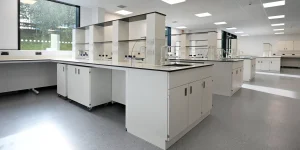Laboratory benches are central to the functionality and efficiency of any laboratory. Their design, material, and placement play a crucial role in determining the effectiveness of lab work.
Types of Lab Benches
Chemistry Lab Bench
The chemistry lab bench is specifically designed for chemical experiments. It typically features chemical-resistant surfaces and is built to withstand corrosive substances and high temperatures. These benches often include built-in sinks, gas taps, and storage for chemicals and equipment.
Biology Lab Bench
Biology lab benches are tailored for biological studies. They usually have a flat, smooth surface that's easy to clean, and often feature built-in microscopes or other biological analysis equipment.
Physics Lab Bench
These benches are designed for physics experiments. They often include features like electrical outlets, robust clamps for holding equipment, and vibration-resistant surfaces to ensure precise measurements.
Key Features of Lab Benches
Material Quality
The material of a lab bench determines its durability and resistance to chemicals, heat, and physical impact. Common materials include stainless steel, epoxy resins, and phenolic resins, each offering different levels of durability and chemical resistance.
Dimensions and Specifications
Lab benches come in various sizes, typically ranging from 4 to 8 feet in length, with a standard height of about 30 inches. The width can vary, but a common standard is 24 inches, providing ample workspace while accommodating lab equipment and tools.
Cost and Budget Considerations
The cost of lab benches varies depending on material, size, and additional features. A basic chemistry lab bench can start from $200 and go up to several thousand dollars for high-end models with extensive features.
Efficiency and Performance
Efficiency in a lab bench relates to how well it supports laboratory workflows. Features like drawer organizers, adjustable shelves, and integrated power sources contribute to a bench's efficiency.

Advantages and Disadvantages
The primary advantage of a well-designed lab bench is its ability to enhance lab productivity and safety. However, the downside can be the cost, especially for high-quality, specialized benches.
Conclusion
Lab benches are more than just furniture; they are integral to the successful operation of a laboratory. When choosing a bench, it's important to consider the specific needs of your lab work, the material and quality of the bench, and your budget. With the right lab bench, you can ensure a safe, efficient, and productive laboratory environment.